OCZ Announces ZD-XL PCIe SQL Accelerator SSD Solution
by Anand Lal Shimpi on July 23, 2013 8:00 AM EST- Posted in
- Storage
- IT Computing
- SSDs
- OCZ
- Enterprise SSDs
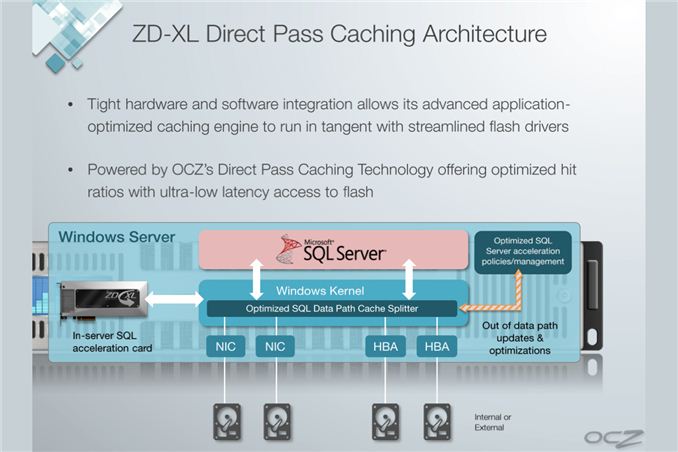
About a year and a half ago OCZ announced the acquisition of Sanrad, an enterprise storage solutions company with experience in flash caching. Today we see some of the fruits of that acquisition with the announcement of OCZ's first SQL accelerator card: the ZD-XL.
Enterprise accelerator cards are effectively very high performance SSD caching solutions. Some enterprise applications and/or databases can have extremely large footprints (think many TBs or PBs), making moving to a Flash-only server environment undesirable or impossible. The next best solution is use a NAND based SSD cache. You won't get full data coverage, but if you size the cache appropriately you might get a considerable speedup.
OCZ's ZD-XL is specifically targeted at servers running Microsoft SQL. Although technically the solution caches all IOs to a given volume, OCZ's ZD-XL software is specifically tuned/optimized for SQL server workloads. The ZD-XL only supports a physical Windows Server environment, OCZ offers a separate line of products for accelerating virtualized environments.
The ZD-XL SSD itself is based on OCZ's Z-Drive r4, featuring 4 or 8 SF-2000 series controllers on a single PCIe Gen 2 x8 card, depending on capacity. OCZ doesn't make the NAND or controller, but the card is built in-house. The ZD-XL implementation comes with a custom firmware and software solution, courtesy of OCZ's Sanrad team. The architecture, at least on paper, looks quite sensible.
The ZD-XL card comes with a special firmware that enables support for the ZD-XL software layer, preventing Z-Drive r4 owners from simply downloading the ZD-XL caching software and rolling their own solution. The software layer is really where the magic happens. All IOs directed at a target volume (e.g. where your SQL database is stored) are intercepted by a thin driver (cache splitter) and passed along to the target volume. An out-of-band analysis engine takes a look at the stream of IOs and determines which ones are best suited for caching. Frequently accessed data is copied over to the ZD-XL card, and whenever the cache splitter sees a request for data that's stored on the ZD-XL it's served from the very fast PCIe SSD rather than from a presumably slower array of hard drives or high latency SAN.
The analysis engine supports multiple caching policies that it can dynamically switch between, depending on workload, to avoid thrashing the cache. There's even cache policy support for deployment in a SQL AlwaysOn environment.
OCZ's software supports automated pre-warming of the cache. For example, if you have a large query that runs between 9AM and 11:30AM every day the ZD-XL can look at the access patterns generated during that period and ensure that as much of the accessed data is available in the cache as possible during that time period.
OCZ's ZD-XL can be partitioned into cache and native storage volumes. In other words you don't have to use the entire capacity of the card as cache, you can treat parts of it as a static volume (e.g. for your log files) and other parts of it as a cache for a much larger database.
The large capacities OCZ offers with the ZD-XL (600GB, 800GB, 1.6TB) will likely help ensure good cache utilization, although there's no pre-purchase way of figuring out what the ideal cache size would be for your workload. This seems to be a problem with enterprise SSDs in general - IT administrators have to do a lot of work to determine the best SSD (or SSD caching) solution for their specific environment, there aren't many tools out there to help categorize/characterize a workload.
OCZ published a white paper showing performance gains for simulated workloads with and without the ZD-XL accelerator. In all of OCZ's test cases the improvements were tremendous, which is what you'd expect when introducing a giant PCIe SSD into a server that previously only had big arrays of mechanical hard drives. Queries complete quicker, servers that aren't CPU bound can support more users, etc...
Just as we've seen in the client space, SSD caching can work - the trick is ensuring you have a large enough cache to have a meaningful impact on performance. Given that the smallest ZD-XL is already 600GB, I don't think this will be an issue.
The only other requirement is that the caching software itself needs to be intelligent enough to make good use of the cache. OCZ's internal test data obviously shows the cache doing its job well in caching very long queries. Building good caching software isn't too difficult, it's just a matter of implementing well understood caching algorithms and having the benefit of a large enough cache to use.
The ZD-XL is priced at $7800, $9800 and $15,200 for 600GB, 800GB and 1.6TB capacities. The prices include software and drivers.



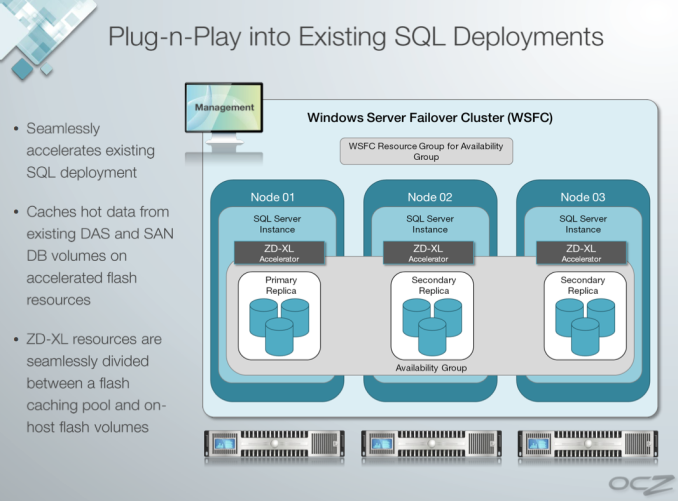
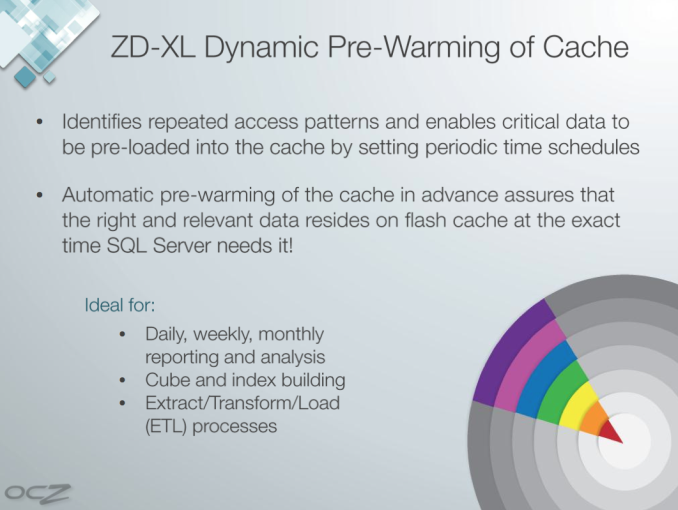
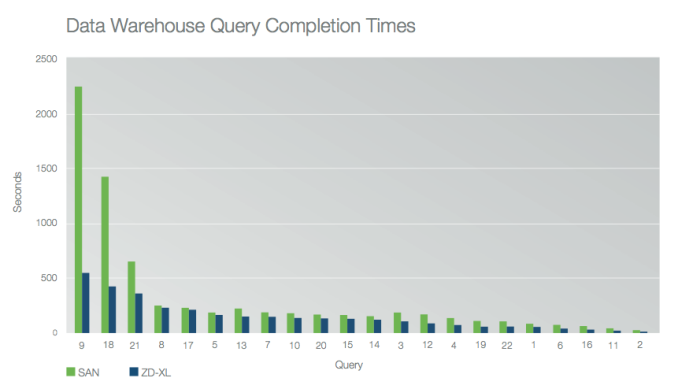
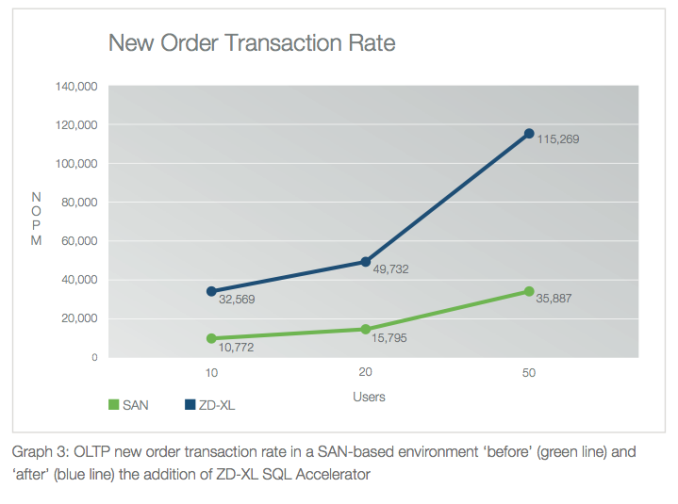
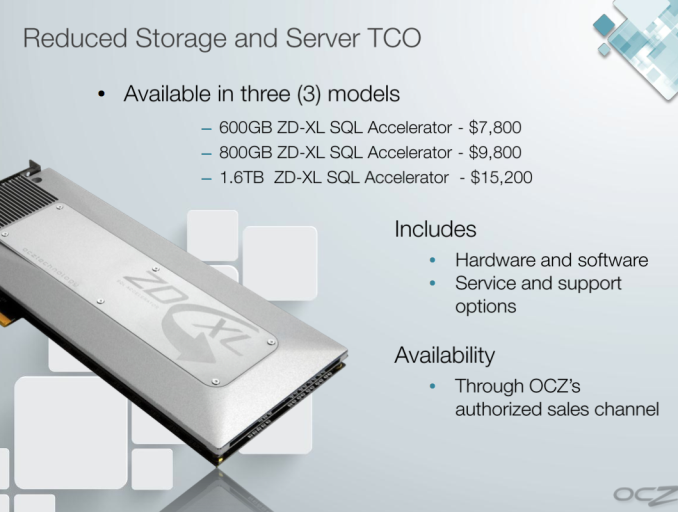








26 Comments
View All Comments
enealDC - Wednesday, July 24, 2013 - link
I'm not sure how well this product will do in large IT enterprises (which are the only ones with the budget to spend 7 or 15K on an acceleration solution for SQL)Companies that need this kind of performance are going to go with time tested solutions from major Enterprise vendors that already have established products along these lines..
themightyone - Friday, July 26, 2013 - link
I love all my OCZ products I have bought to upgrade my laptops. They are so so so so so fast I can't even describe it. Restarts and booting up now are like nothing. How can I ever go back to HDD's...never. Never had one fail on me yet and I have been using them for years. I think this Sql server solution also won interlop in las vegasthemightyone - Friday, July 26, 2013 - link
have you ever tried other SSD brands, intel and kingston and the sandisk ones suck. Way slow compared to SSD standards and I'm always having problems with themthemightyone - Friday, July 26, 2013 - link
i'm not sure you know what you're doingclonardo - Wednesday, July 31, 2013 - link
So far, all of the complaints in the comments are on OCZ's consumer-grade gear. OCZ Enterprise seems to be a fairly distinct unit, from what I can tell, with a different site, different hardware, and different standards.I've been running an OCZ Z-Drive R4 (which was $2200 for a 300gb model) for around 6 months in a financial environment, and the biggest issue that I've had is driver support. You really can't plug and play a drive like this- the array of controllers (4 on my 300gb, 8 on the biggers ones) need OCZ's closed-source drivers to work correctly. OCZ had an extremely limited offering of Linux drivers, and didn't have anything at all that would work with the servers that I was running (our kernel was too new). According to the research I did at the time, and after speaking with OCZ Enterprise support, this is not an uncommon complaint with the Z-Drives. I wasn't able to make the drive work correctly in this environment, and neither were any of my colleagues.
Eventually, I gave up and put it into a high-end Windows workstation. At the time (not sure if this is still the case), there were no Windows 8 drivers available, and I didn't want to chance it after my Linux fiasco, so I was stuck using Windows 7. Fortunately, it flies, and has been reliable so far. I had planned to use it to accelerate my MySQL server environment, but went a slightly different direction since that was ultimately impossible. As a client-side device, it's pretty awesome, and I am still able to realize a benefit.
It's extremely disappointing that this is only being offered for Microsoft SQL Server, as this would be really interesting with Percona. However, OCZ's tradition of crap Linux drivers seems to have caused them to just give up on it.
geok1ng - Sunday, August 4, 2013 - link
the very idea of using OCZ for anything in a server environment looks like a BOFH plan. I still regret the day i took anandtech's advice and got a 1st gen vertex. that thing ( i refuse to call it an ssd) died so many times, and i lost so much data because of destructive firmware "upgrades" after those deaths that i also joined the club of OCZ haters.